Plan your sun-powered meals strategically throughout the week to maximize solar cooking success. You'll want to schedule quick-prep dishes like Salsa Verde Soup and Sheet Pan Pineapple Chicken for weekdays, saving time-intensive recipes for sunny weekends. Start your mornings with solar-baked breakfast casseroles and oatmeal, then enjoy protein-packed lunches like teriyaki salmon bowls or Mediterranean chicken orzo. For family dinners, try hearty options such as Basque Chicken, Solar Lasagne, or Tandoori Chicken. Don't forget to include sweet treats like Solar Eclipse Cookies. The right combination of timing, equipment, and recipes will transform your weekly meal planning.
Planning Your Solar Cooking Schedule
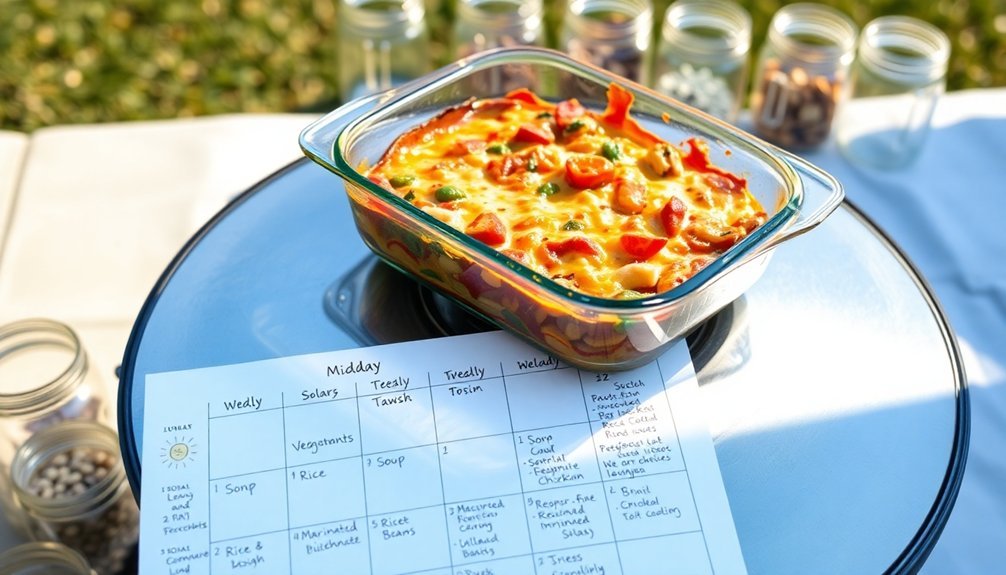
When planning your weekly solar cooking schedule, understanding ideal cooking times and weather patterns is essential for success.
You'll want to focus on the prime cooking window between 11:00 am and 3:00 pm when the sun is directly overhead. Using reflective surfaces helps maximize heat capture during this peak period. Check weather forecasts and plan your meals accordingly – reserve sunny days for time-intensive dishes like beans and bread, while keeping quick-cooking items like rice for partially cloudy days.
Start by creating a weekly menu that aligns with expected weather conditions. Pre-soak ingredients the night before and set up your solar cooker an hour early to preheat.
During cooking, you'll need to reposition the cooker regularly to track the sun's movement. Remember to rotate solid foods every 10-15 minutes and stir liquids every 10 minutes for even cooking.
Essential Solar Cooking Equipment
Successful solar cooking relies on having the right equipment for your specific needs and cooking style.
You'll need to choose from different solar oven types based on your cooking goals and available space. Box cookers are perfect for everyday meals, while parabolic models reach higher temperatures for faster cooking. Optimal cooking results are achieved by propping the flap open to direct maximum sunlight into your cooker.
Essential items for your solar cooking setup include:
- Dark-colored pots or glass jars to absorb heat efficiently
- A reliable thermometer to monitor cooking temperatures
- Aluminum foil for reflecting sunlight effectively
- Clear plastic wrap or bags to create a greenhouse effect
Don't forget to add basic safety features like venting holes if you're using sealed containers.
For better heat retention, you'll want to incorporate insulating materials like newspaper around your cooking vessel, especially when preparing longer-cooking dishes.
Monday Through Sunday Meal Guide
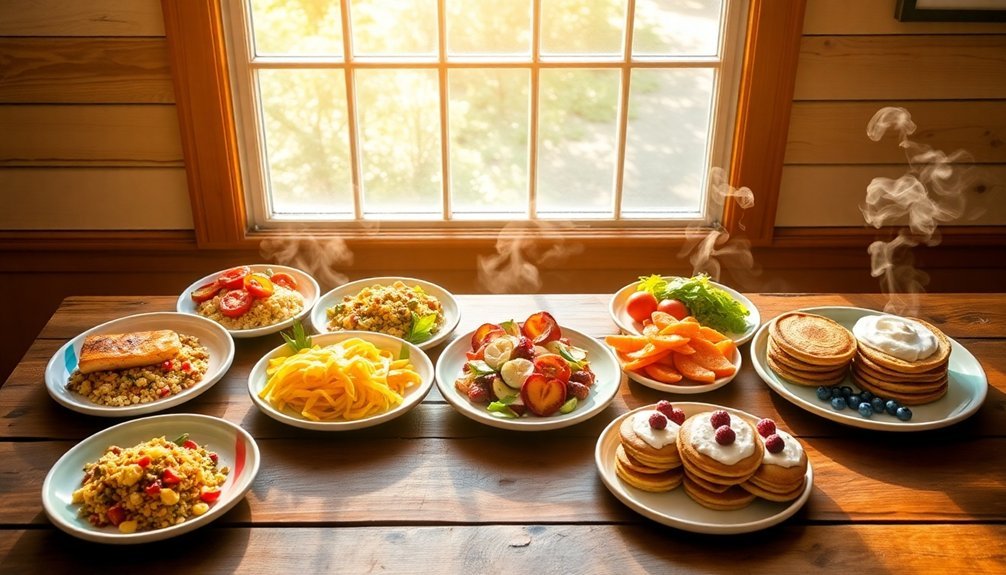
You'll find weekday solar cooking maximizes efficiency with quick-prep options like Salsa Verde Soup and Sheet Pan Pineapple Chicken, while weekends allow time for more elaborate dishes such as Solar Lasagne and Cherry Dump Cake.
Planning your shopping around ingredients that work in multiple recipes helps reduce waste and saves money, like using ground beef for both Broccoli Beef and tacos. Weekly meal plans shared on Fridays provide additional inspiration for efficient meal planning and prep.
Smart meal scheduling lets you cook larger portions early in the week to transform leftovers into new dishes later, making the most of your solar cooking setup.
Weekday Quick Solar Meals
Planning weekday meals with solar cooking requires strategic scheduling to maximize sunlight hours and minimize preparation time.
You'll find quick breakfast options like the Solar Cooker Breakfast Frittata and Open Faced Omelette, both ready in under 45 minutes.
For efficient meal management throughout the week, focus on these time-saving approaches:
- Prepare the Tandoori Chicken in just 35 minutes total for a flavorful lunch
- Use the solar pot for set-and-forget stews while you're at work
- Start dinner dishes like Italian Polenta early in the day
- Choose make-ahead options like Pumpkin Scones that stay fresh
When time is tight, opt for dishes with minimal prep work, like the EZ Solar Pot Pie or Solar Spaghetti.
You'll discover that many solar recipes allow for passive cooking while you attend to other tasks. The zero CO2 emissions from solar cooking make it an environmentally responsible choice for your weekly meal preparation.
Weekend Family Feasts
Moving beyond quick weekday meals, these daily solar cooking guides help you make the most of family mealtimes throughout the week. You'll find hearty options like solar-cooked lasagne that takes 90 minutes to prepare and barbecued ribs that cook for 2-4 hours, perfect for leisurely weekend cooking.
| Day | Main Dish | Side/Dessert |
|---|---|---|
| Friday | Beef/Pork Stew | Lemon Glazed Cake |
| Saturday | Solar Lasagne | Biscotti |
| Sunday | Tandoori Chicken | Pumpkin Scones |
| Special | Barbecued Ribs | Italian Polenta |
Mix and match these dishes to create memorable weekend feasts. For extra variety, try the solar pumpkin fry bread or sugared cinnamon almonds as snacks between meals. Your solar oven transforms weekend cooking into an eco-friendly family activity while delivering delicious results.
Smart Ingredient Shopping Tips
As solar cooking becomes a regular part of your weekly routine, smart ingredient shopping makes all the difference in staying organized and efficient. Before heading to the store, check your pantry and create a detailed shopping list based on your planned solar-cooked meals.
You'll want to focus on ingredients that work well with sun-powered cooking methods.
Essential shopping strategies for solar meal success:
- Buy seasonal produce in bulk when prices are low, as many vegetables and fruits are perfect for solar cooking.
- Stock up on dried beans, grains, and pasta that store well and form the foundation of many solar dishes.
- Choose cuts of meat that benefit from slow cooking, like chuck roast or chicken thighs.
- Purchase heat-resistant containers and storage solutions specifically for solar cooking.
Remember to track what you've bought and used to minimize waste and maximize your solar cooking budget.
Breakfast Solar Cooking Success
You'll master egg dishes quickly by learning to position your solar cooker for ideal sun exposure and preheating your cast iron skillet for 10 minutes.
Your sunny-side-up eggs need just 3 minutes of cooking time when placed at the focal point of a parabolic cooker, while baked eggs require 45-60 minutes in a solar oven.
Managing your breakfast timing means starting with a preheated solar oven and using stack cooking to prepare multiple dishes simultaneously, ensuring you'll have a complete meal ready when needed.
Quick Egg Dish Mastery
Mastering solar-cooked eggs transforms ordinary breakfast routines into exciting culinary adventures.
You'll need a solar box oven, black cookware, and basic supplies to get started. For best results, preheat your oven in direct sunlight and separate your eggs to prevent browning or cracking.
Cooking times vary by season, with summer offering the quickest results at 10-23 minutes.
You can create diverse egg dishes by:
- Adding garlic powder, milk, and cheese for fluffy omelets
- Cooking sunny-side up eggs in a preheated cast iron pan
- Preparing hard-boiled eggs without water for richer flavor
- Combining eggs with pre-cooked solar bacon for a complete meal
Remember to adjust your cooking times based on weather conditions and outside temperature.
In winter months, expect longer cooking periods of 1-2 hours for perfect hard-boiled eggs.
Efficient Breakfast Time Management
Successful breakfast preparation with solar cooking depends on efficient time management and thoughtful planning.
You'll save precious morning time by positioning your solar oven early to catch the first sunlight while assembling ingredients you've prepped the night before.
Make your mornings smoother by scheduling your weekly solar breakfasts in advance. You can stack-cook multiple items simultaneously, like eggs and pancakes, maximizing your solar oven's efficiency.
For flexible timing, prepare overnight dishes like breakfast casseroles or oatmeal that can be ready when you need them.
Pre-assemble nutritious ingredients by combining whole grains, lean proteins, and fresh fruits into your solar recipes.
When weather's unpredictable, keep backup options ready, such as pre-cooked portions you can quickly reheat or no-cook alternatives like yogurt parfaits.
Protein Rich Solar Lunch Options
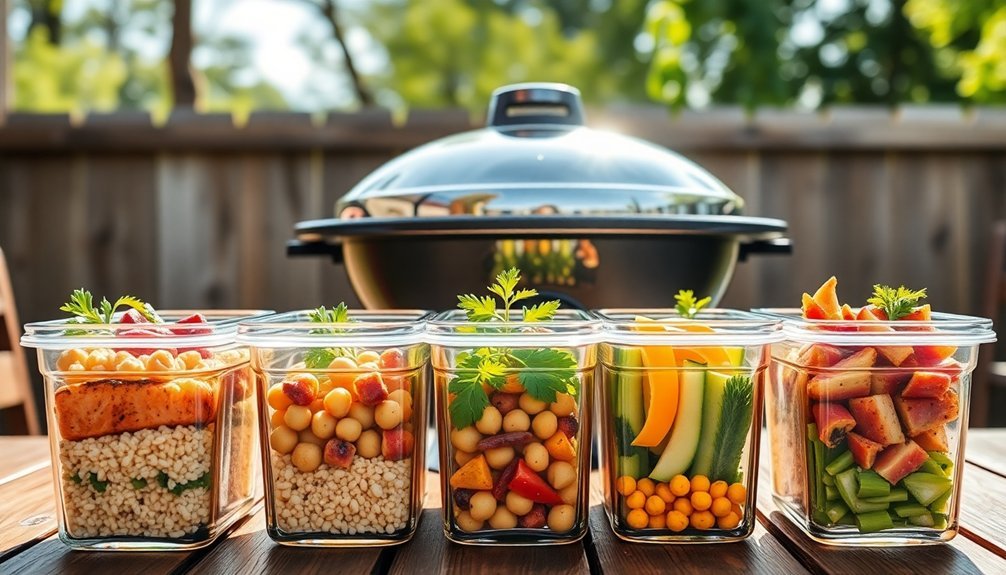
Whether you're seeking a hearty post-workout meal or a midday energy boost, protein-rich solar lunches offer an eco-friendly way to fuel your body.
Your solar cooker can perfectly prepare high-protein options like teriyaki salmon bowls packing 40g of protein or Mediterranean chicken orzo delivering 28g per serving.
For quick-prep solar meals that pack a protein punch, try these versatile options:
- Lentil and beef stew with Moroccan spices (30g protein)
- Greek quinoa salad topped with chicken (22g protein)
- High-fiber spinach bowl with edamame and almonds (20g protein)
- Tuna pasta salad with lemon-dill dressing (14g protein)
You can boost any solar-cooked lunch by adding protein-rich toppings like canned salmon, seitan, or Greek yogurt.
These ingredients maintain their nutritional value while cooking in your solar oven.
Family Dinner Solar Recipes
Dinnertime presents the perfect opportunity to harness solar energy for creating memorable family meals.
You'll find delicious options like Basque Chicken, which combines tender chicken breast with Mediterranean vegetables in a flavorful white wine sauce.
For Italian cuisine lovers, you can prepare a hearty Solar Lasagne layered with cheese and sausage, perfect for larger families.
If you're craving something exotic, try Tandoori Chicken marinated in yogurt and aromatic spices, ready in just 35 minutes.
When you want a vegetarian option, the Vegetable Stew offers a nutritious blend of seasonal vegetables simmered in herbs.
To guarantee success, you'll need to choose the right solar oven for your recipe.
Panel ovens work well for gentle cooking, while parabolic ovens are ideal for higher-temperature dishes.
Sweet Solar Treats
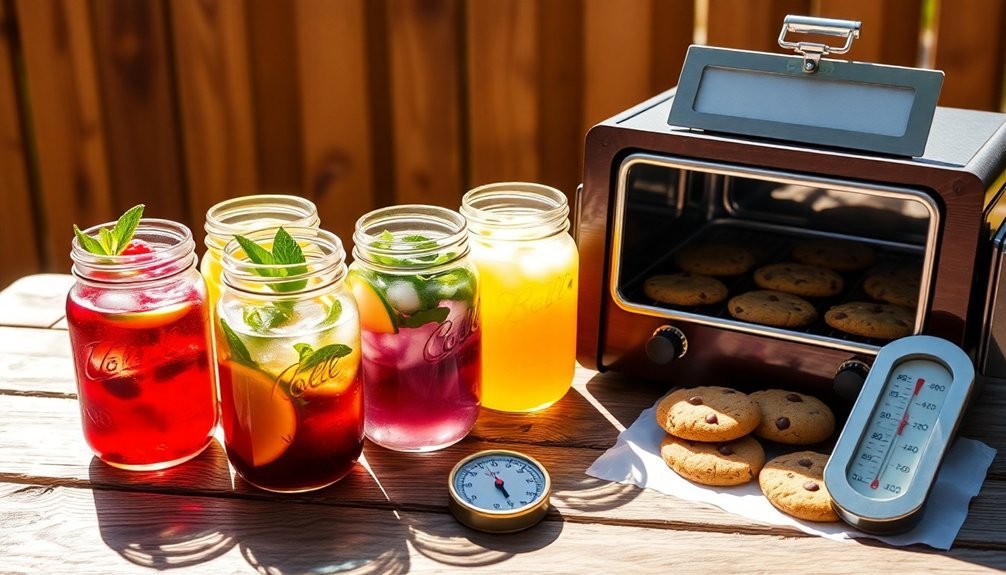
Delighting in sweet treats becomes even more enjoyable when you harness the power of solar cooking.
You'll find various sun-inspired desserts perfect for eclipse viewing parties or any sunny afternoon.
For quick and easy options, try these solar-themed treats:
- Solar Eclipse Cookies combining fudgy brownie and sugar cookies
- Cupcakes topped with yellow frosting and OREO "moons"
- No-bake Ritz Cracker suns with pretzel rays
- Marble cake baked in a parabolic solar cooker
If you're ready to use actual solar power, your solar oven can transform simple ingredients into delicious desserts.
Try baking easy bar cookies using cake mix, eggs, and melted butter. The process takes longer than conventional baking, but you'll love how the sun's energy creates perfectly baked treats while saving electricity.
Tips For Efficient Solar Cooking
To maximize your solar cooking success, understanding proper setup and technique makes all the difference. Position your solar oven to catch ideal sunlight, using reflective materials like aluminum foil to concentrate heat. You'll want to choose dark-colored cookware that absorbs radiant energy efficiently – black cast iron pots and dark glass dishes work best.
| Time of Day | Setup Tips | Safety Notes |
|---|---|---|
| Morning | Angle reflectors east | Check thermometer |
| Midday | Position directly south | Use oven mitts |
| Afternoon | Adjust west as sun moves | Monitor food temp |
Don't add water when cooking vegetables or meats, as this preserves nutrients. For grains and legumes, use traditional water ratios. Track your cooking times and temperatures to refine future meals, and always verify thorough cooking during peak sun hours between 10:00 a.m. and 2:00 p.m.
Frequently Asked Questions
How Do Cloudy Days Affect the Taste of Solar-Cooked Meals?
You'll find that cloudy days don't greatly alter your solar-cooked food's taste. The gentle, slow cooking method still preserves natural flavors and textures, though you'll need more time to achieve the same results.
Can Solar Ovens Be Used for Cooking Frozen Ingredients Directly?
Yes, you can cook frozen ingredients directly in your solar oven. You'll need longer cooking times, but it's safe and effective. Just remove any packaging first and consider using dark-colored cookware for better results.
What Foods Should Never Be Prepared in a Solar Oven?
You shouldn't cook delicate proteins, frozen foods, fried items, or time-sensitive dishes in a solar oven. It's also best to avoid foods that need precise temperatures or quick cooking times for safety reasons.
How Long Can Solar-Cooked Meals Safely Stay Warm in the Oven?
You'll need to keep your solar-cooked food above 140°F for safety. Once temperatures drop below this, you must consume or properly cool it within 2 hours to avoid the dangerous bacterial growth zone.
Is It Possible to Solar Cook Multiple Dishes at Different Temperatures Simultaneously?
Yes, you can cook multiple dishes at different temperatures simultaneously. You'll need a box cooker for multiple dishes, or you can use several panel cookers. Control temperatures by adjusting reflectors and lid positions.
In Summary
You'll find solar cooking transforms your weekly meal planning into an eco-friendly adventure. With proper equipment and timing, you're able to harness the sun's power for everything from breakfast frittatas to slow-cooked dinners. Just remember to check weather forecasts, prep ingredients in advance, and keep backup cooking methods handy. By following these solar recipes and tips, you'll master the art of sun-powered cooking.


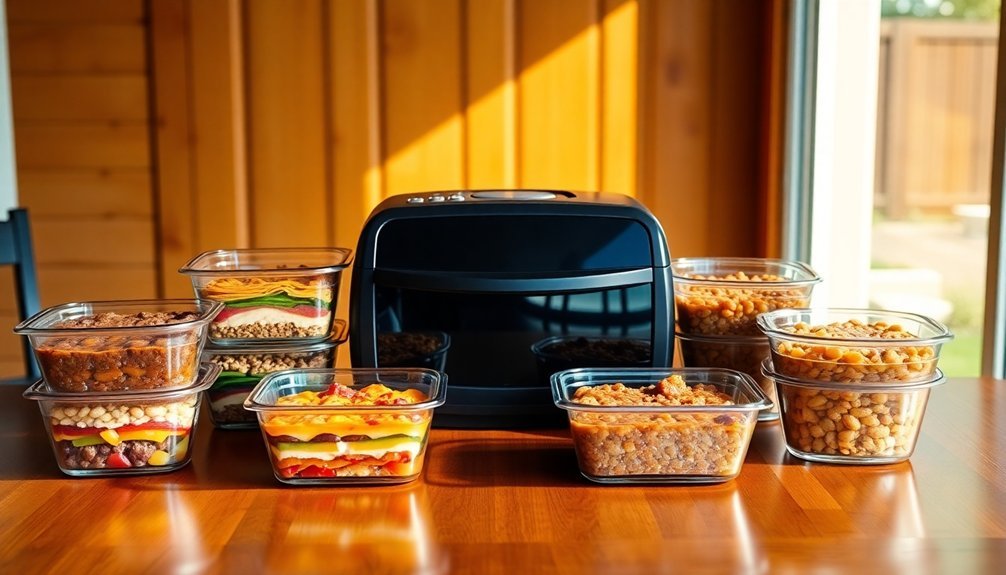
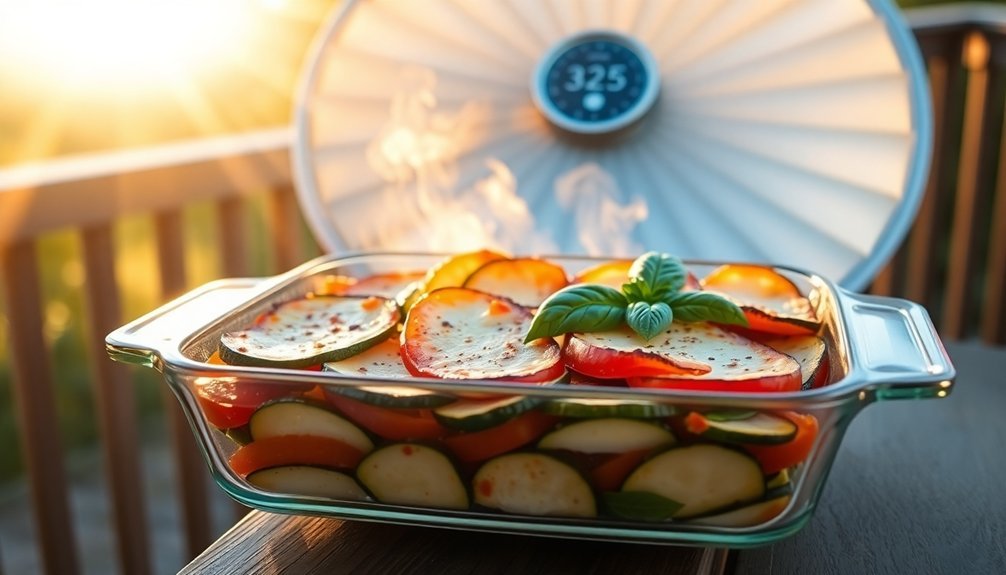
Leave a Reply